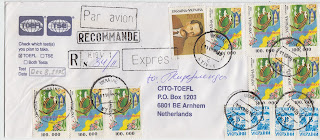No cover has ever baffled me as much as this one. I have zero doubt that it is genuine. For one thing, it's part of the Zhdanovich correspondence - a large correspondence addressed to members of the Zhdanovich family, mostly living in the Crimea - but it's also too odd to really be a forgery. And that's not even mentioning the censor marking, etc.
Let's start by taking a look at the front:
It's a registered letter, sent in March 1919 from Vladivostok. It's addressed to Simferopol' on the Crimea.
What?
Obviously, the direct mail route from Vladivostok to the Crimea through Siberia and European Russia was no longer available by then. Mail from Eastern Siberia to Europe generally went via Japan, the USA and Great Britain. But it's very much unclear if there was any way to get mail from Britain to the Crimea, and that's not even mentioning the fact that the Crimea was about to get its (second) period of Soviet Rule in April 1919.
But the puzzle just gets weirder when you look at the reverse:
We see the usual Vladivostok censor marking, and a cachet indicating that postage was paid in cash, as entirely normal for inland registered letters from this period. The rate should be 1.05 ruble. But! There's also a Simferopol' arrival marking! And a manuscript note that the letter was received on 13 September 1919...Somehow, the letter got to its destination, half a year after it was sent. At least 3 months of that delay were probably due to the second Soviet rule over Crimea, which ended in late June/early July.
The great problem the Whites faced in the Civil War was that their zones of influence and staging areas for attack were such disjointed, peripheral areas. No two zones of White influence (West, North, South and Siberia) ever succeeded in making much contact, let alone coordinating their military activities. As a result, the Red Army could (and did) defeat them one by one. Kolchak, Yudenich, Denikin...they all failed, one by one.
Another result of this geographical disjointedness is that I have NEVER seen an item of mail that went from one zone of White influence to another. Except for this letter.
It may not look that exciting but this may be the most unusual letter from the White side in the Civil War.
© Ivo Steijn, 2016. Unauthorized use and/or duplication of this material without express and written permission from this site’s author and/or owner is strictly prohibited. Excerpts and links may be used, provided that full and clear credit is given to Ivo Steijn with appropriate and specific direction to the original content.















